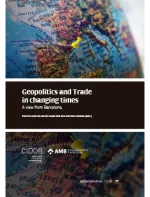Value chains and trade in Barcelona. A historical view and a proposal for the future

“We are in a context of war”. Not a quote from a 100-year-old document from when Barcelona’s companies were stressed by the import shortages and inflation caused by World War I, the population suffered one of the 20th century’s deadliest pandemics and value chains and trade in the city and across Europe were broken, and more profoundly than today. No. These were the words of Martín Sellés, President of Farmaindustria, the Spanish pharmaceutical trade association on September 3rd 2020. Farmaindustria is an association of 141 laboratories, as of June 29th 2020; 45 are national, while the others are subsidiaries of or owned by multinationals from the rest of Europe and the United States. Among the national companies are some of the oldest family groups created in Barcelona, such as Almirall, Esteve and Ferrer. Grifols is not a member of Farmaindustria, but it produces medicines and is one of the world’s three largest plasma derivatives companies. Its corporate headquarters are in Sant Cugat del Vallés and its historic headquarters in Calle de Jesús y María next to Paseo de la Bonanova in Barcelona. The words of the President of Farmaindustria are important. He speaks on behalf of a highly competitive, internationalised sector, in which Barcelona has shone since the first third of the 20th century with a resilience that is closely linked to the existence of networks with the outside world. It is a sector that has been accustomed, since the 1920s, and especially after World War II and the boost given by entry to the EEC, to stable alliances with companies from leading countries.